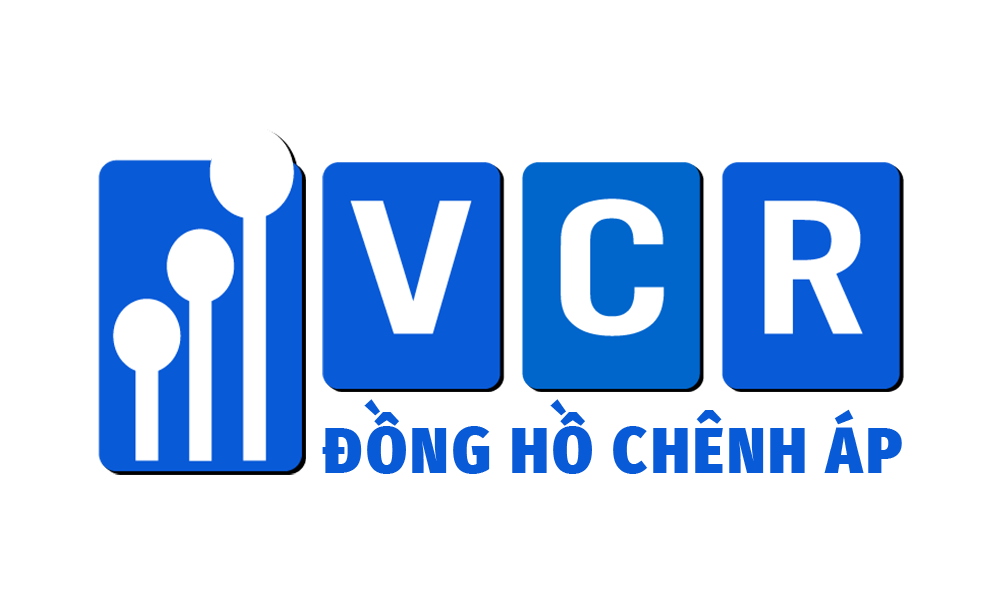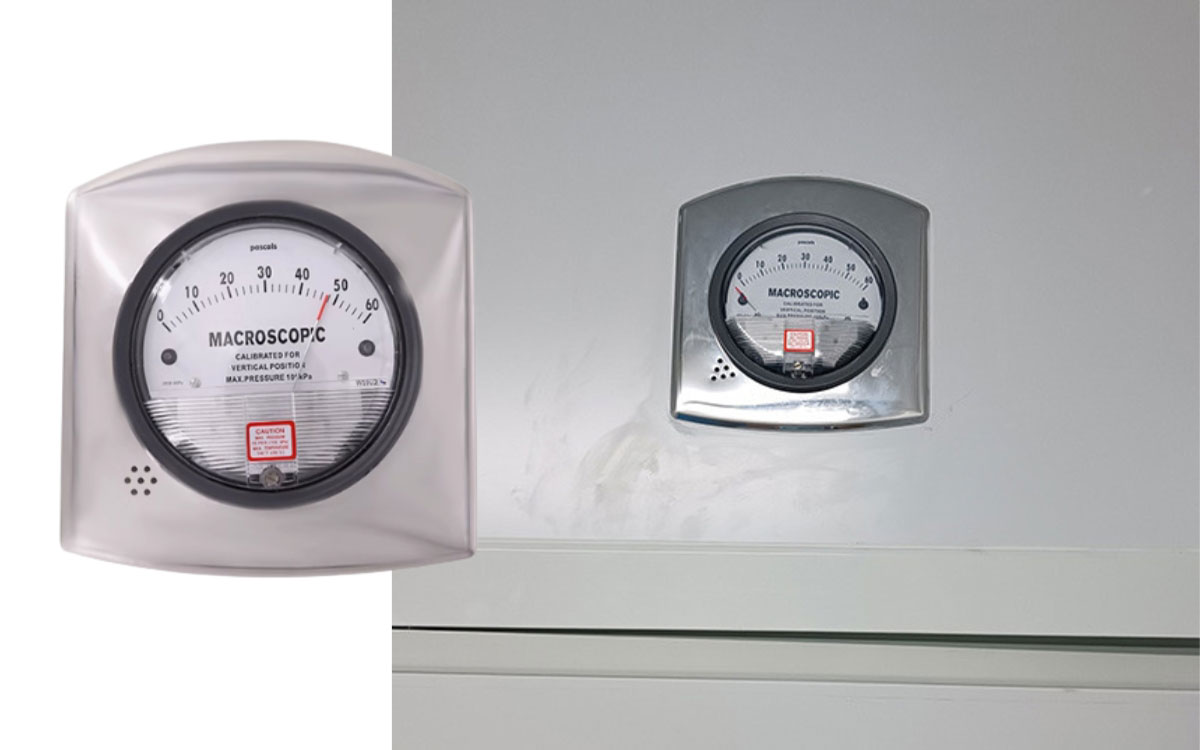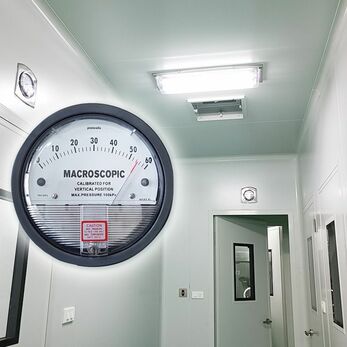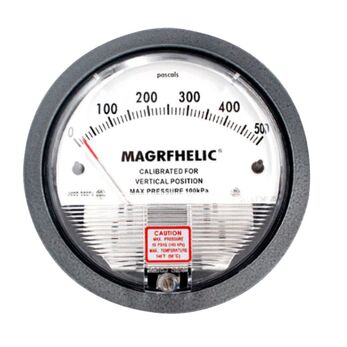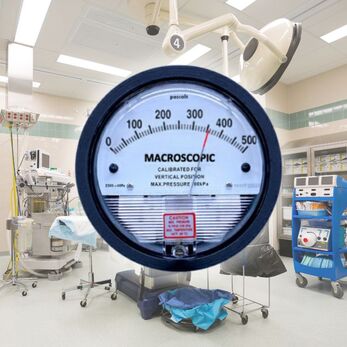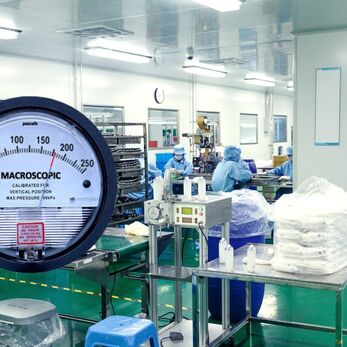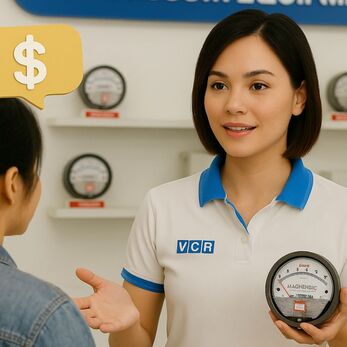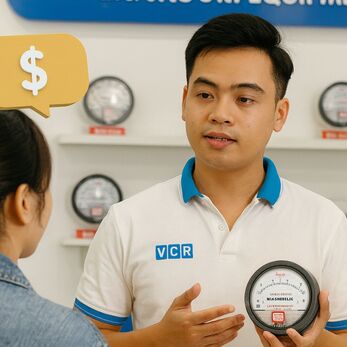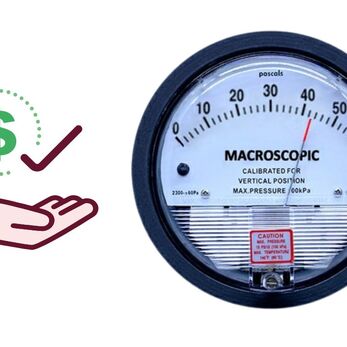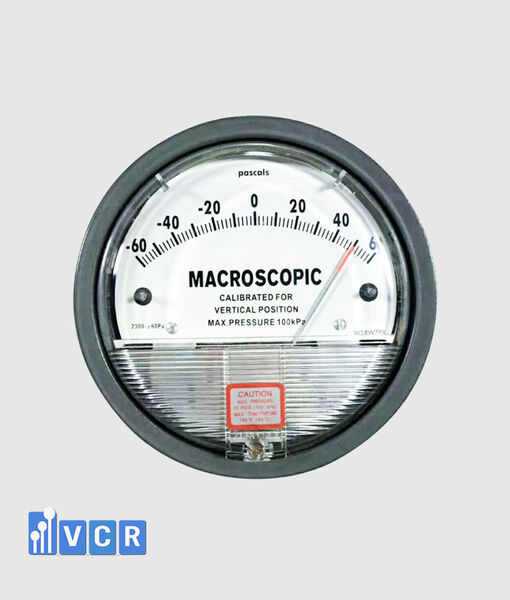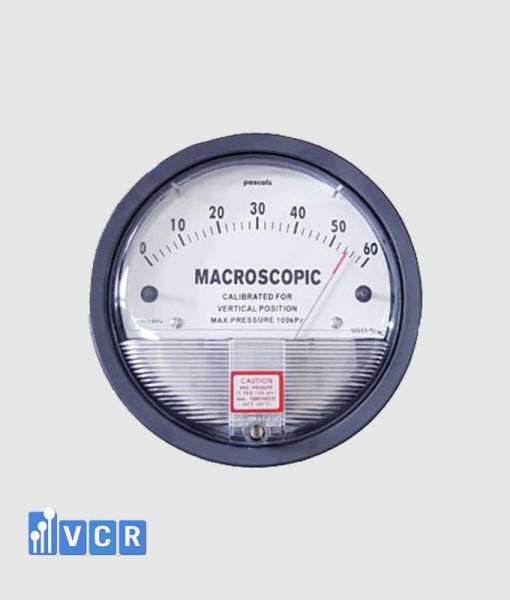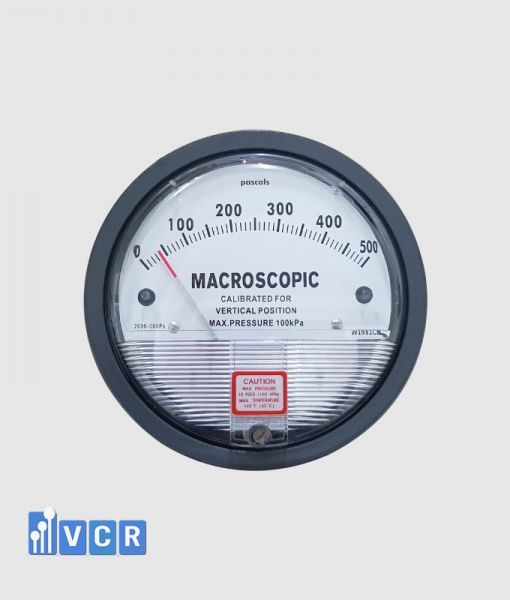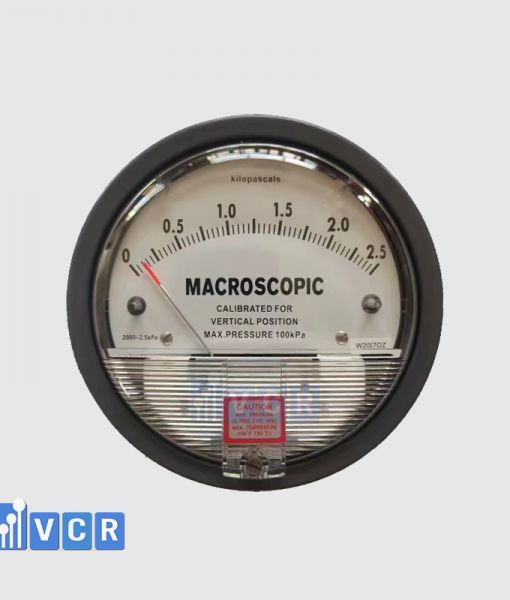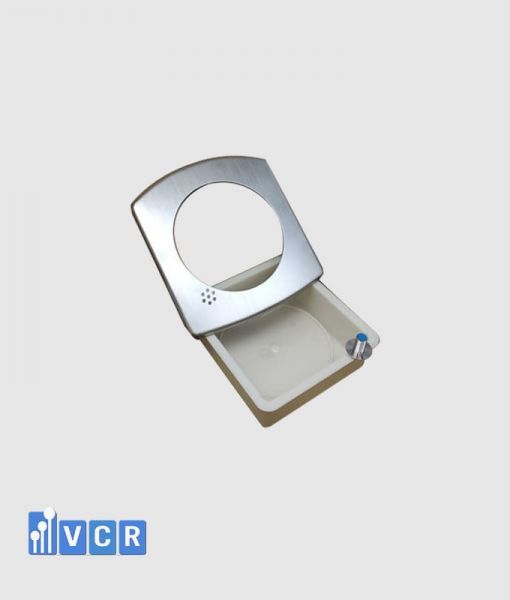Calibration of differential pressure gauges is an important step to ensure that a clean room system operates stably and complies with GMP. This article guides you through the process, frequency, standards, and considerations when calibrating—helping maintain the accuracy and lifespan of pressure measurement instruments.
1. What is a Differential Pressure Gauge?
Short definition
A differential pressure gauge is a cleanroom differential pressure device used to measure the pressure difference between two areas. It helps detect even the smallest pressure changes, thereby providing early warning of abnormalities in the environmental control system.
Role in clean-room pressure monitoring
In clean rooms—especially environments with strict control requirements such as pharmaceutical production, functional foods, electronics manufacturing or premium cosmetics—maintaining stable pressure is a key factor to prevent cross-contamination and protect the “clean” zone.
Differential pressure gauges are installed at locations such as:
-
Between two rooms of different cleanliness classes
-
Before and after a HEPA filter
-
At the entrance/exit of an airlock or pass-box
By continuously monitoring the differential pressure value, the operator can detect:
-
Pressure exceeding the allowable limit (warning of dust/biological contamination risk)
-
Filter blockage requiring replacement
-
Loss of pressure due to technical failure or doors left open too long
Sector-specific applications
-
Pharmaceutical industry: Monitoring pressure between the compounding zone and packaging zone; ensuring production compliance with GMP-WHO.
-
Food industry: Used in processing plants for dairy, canned goods, confectionery that require localized clean zones.
-
Electronics industry: Controls pressure in board, semiconductor, SMT production zones; limits static-dust induced product failures.
-
Cosmetics industry: Applied in premium skin-care and makeup production and packaging zones; ensures the environment remains uncontaminated.
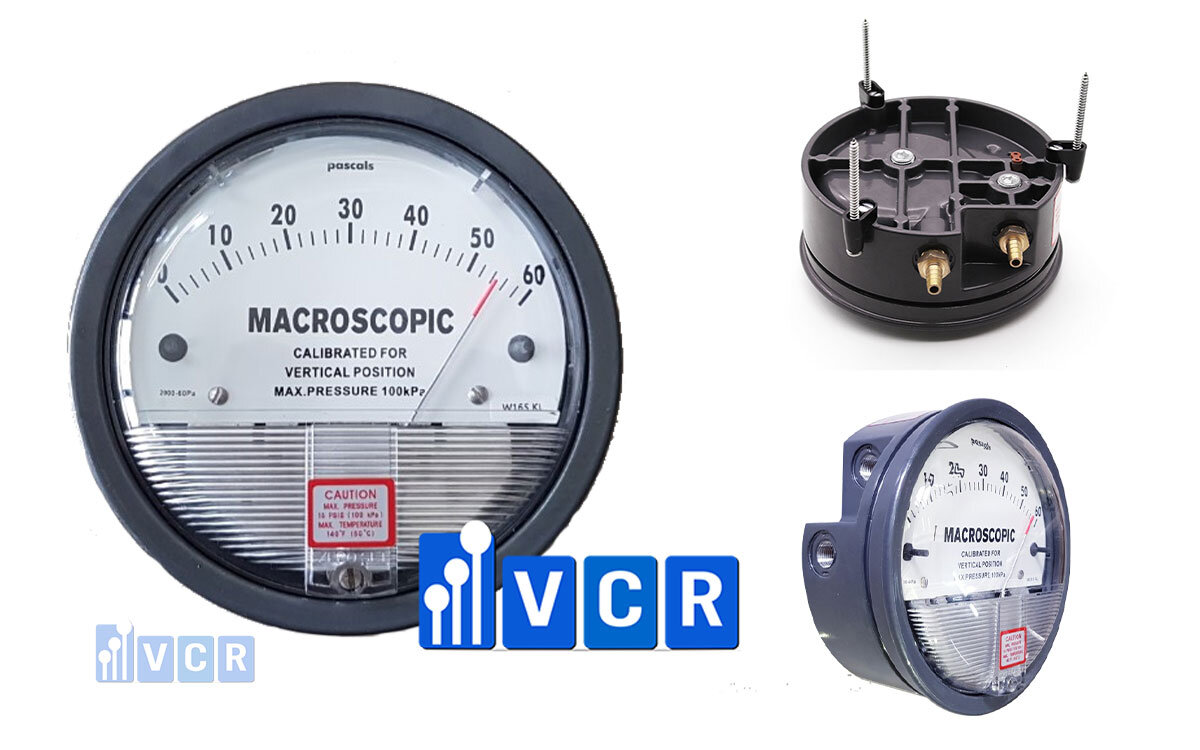
Read more: Latest price list of Differential pressure gauge used in electronics factory
2. Why is Regular Calibration Necessary?
Accumulated error over time
Over time, internal components of a differential pressure gauge—such as sensors, springs, diaphragms—can wear, deform or become coated with dust. These factors alter the sensitivity and accuracy of the instrument. Without regular calibration, small initial errors can accumulate into significant deviations, making the measurement results unreliable.
Impact on clean-room environment control
A differential pressure gauge plays a critical role in early warning when there’s a pressure change between zones. If the device measures inaccurately, the operator may fail to detect in time situations such as:
-
Pressure lower than standard ⇒ risk of contamination penetration
-
Unusually high pressure ⇒ may affect equipment and personnel safety
Regular calibration helps ensure the measurement data always reflect the actual conditions, thus maintaining overall system cleanliness.
Compliance with standards GMP, ISO 14644
International standards such as GMP-WHO, EU-GMP require that measurement equipment in clean rooms be calibrated periodically by capable organisations. The standard ISO 14644-4 requires verification of pressure-monitoring instruments to ensure clean-room conditions are maintained. Failure to comply with calibration can be considered a serious violation during quality system audits.
Audit evidence
During internal audits or regulatory inspections (by health authorities, FDA, ISO organisations…), calibration records are important evidence of the enterprise’s environmental control. Some common deficiencies found when calibration is neglected:
-
No calibration label on the instrument
-
Calibration records incomplete
-
Measured values deviate significantly from reference instruments

Read more: Selecting the Perfect Differential Pressure Gauge for Your Cleanroom
3. Recommended Calibration Frequency
There is no fixed universal calibration cycle that applies to all industries; based on international standards and practical experience, the suggested intervals for differential pressure gauges calibration are as follows:
| Industry | Calibration Interval | Notes |
|---|---|---|
| Pharmaceuticals | Every 6 months | Mandatory per GMP-WHO to ensure compliant production environment. |
| Food | Every 6–12 months | Depends on control level and HACCP/ISO 22000 requirements. |
| Electronics | Every 12 months | Ensuring high accuracy to avoid micro-defect in products. |
| Cosmetics | Every 6–12 months | Flexible according to internal standards or export partner requirements. |
Factors influencing the calibration interval:
-
Equipment usage frequency: continuous operation ⇒ more frequent calibration.
-
Importance of the monitored area: main production zones require stricter control than auxiliary zones.
-
Equipment error history: devices with a history of large deviations require closer monitoring.
Performing calibration at the right interval not only ensures measurement reliability but also reduces the risk of production disruption due to undetected faults.
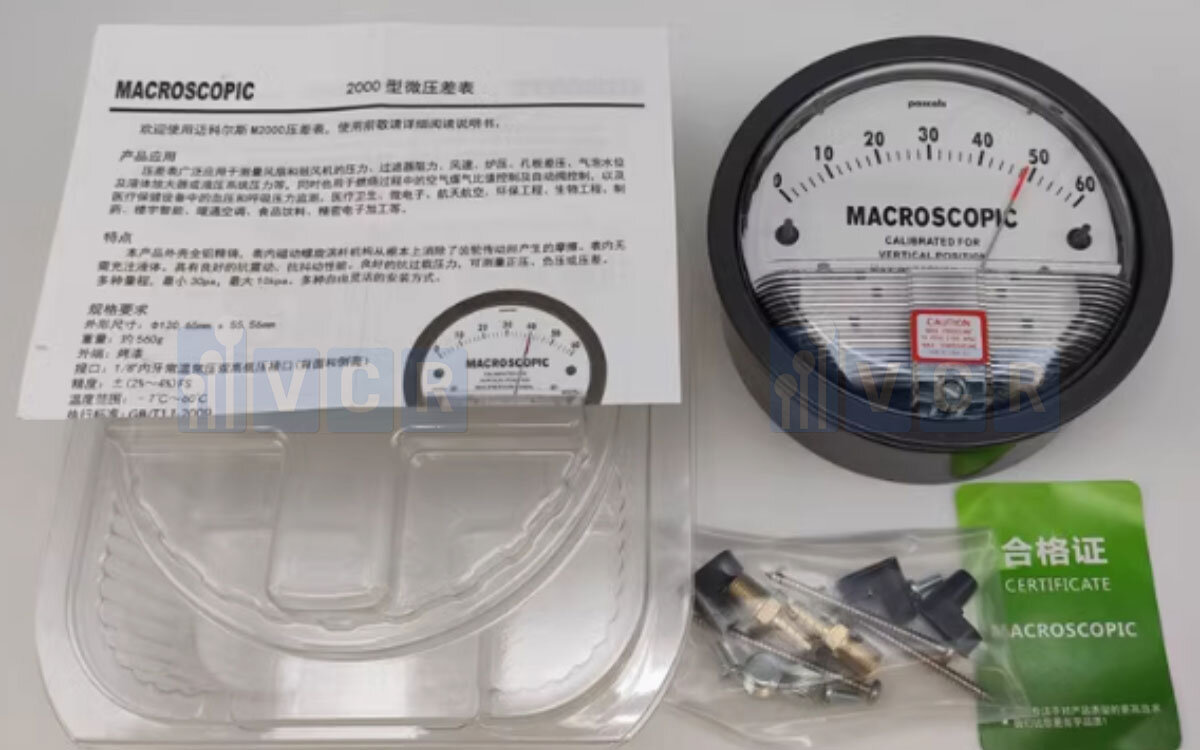
Read more: Digital Differential Pressure Gauge Installation: A Comprehensive Guide
4. Calibration Procedure for Differential Pressure Gauges
Calibration of a differential pressure gauge must follow a technical procedure to ensure accuracy, safety and compliance. The calibration process comprises three main stages:
a. Preparation — Equipment & Environment
-
Reference device: Use a manometer or pressure calibrator which itself has been calibrated by an ISO 17025-accredited body. The reference instrument should have an error margin significantly smaller than the gauge being tested—usually at least 4 times higher accuracy.
-
Calibration environment:
-
The temperature and humidity in the calibration area should be stable to avoid influencing the results.
-
Preferred conditions: ~20-25 °C, 40-60% RH.
-
Avoid drafts, vibration and electromagnetic interference.
-
b. Execution Steps
-
Record the current reading: Before calibration begins, record the gauge’s displayed values for later comparison.
-
Connect the gauge to the calibration equipment: Use airtight tubing to link the high-pressure and low-pressure ports of the gauge to the reference device. Ensure no leaks.
-
Increase/decrease pressure at various set points: Apply pressures at standard values such as:
-
0 Pa
-
10 Pa
-
25 Pa
-
50 Pa
-
100 Pa
At each pressure level, maintain for 30-60 seconds to stabilize reading.
-
-
Record the error at each point: Compare the gauge reading with the reference instrument to determine the deviation. If the error exceeds permitted limits, adjust accordingly.
-
Adjust or replace if error exceeds limits: Follow the manufacturer’s adjustment instructions. If the instrument cannot be adjusted back into tolerance, it must be replaced or withdrawn from service.
c. Calibration Records
After completing the calibration, you must keep full records including:
-
Calibration report: Includes instrument information, date of calibration, the person performing it, environmental conditions, reference device, test results.
-
Result sheet: Lists the error at each pressure point, and pass/fail status.
-
Calibration label: Affixed directly to the device, showing:
-
Date of calibration
-
Next due date
-
Reference document number
Maintaining complete records helps the organization easily present documentation during internal audits or regulatory inspections.
-
Read more: Supplier of Differential Pressure Gauges Used in Food Clean Rooms
5. Who Should Perform the Calibration?
Choosing the entity to perform the calibration of a differential pressure gauge is a key factor determining the reliability of the measurement results and the ability to meet audit requirements. Two common options:
In-house technical team (if qualified)
Some large plants or enterprises with complex clean-room systems build their own calibration team to manage timing and reduce cost. However, to calibrate in-house, they must ensure:
-
They have properly calibrated reference instruments.
-
Technical staff are trained and familiar with GMP, ISO 14644.
-
They have documented SOPs that are validated.
In-house calibration may suit companies whose regulation does not mandate third-party calibration, but complete documentation is still required when under inspection.
ISO 17025-accredited calibration service provider
This is the preferred option and is often required in industries with strict validation demands such as pharmaceuticals, export cosmetics, medical devices. A compliant calibration provider must have:
-
ISO/IEC 17025 accreditation (confirming measurement/test capability)
-
Well-traced reference instruments
-
Trained technical staff
-
Valid calibration reports recognized during audits and by international clients.
It is recommended to use an accredited provider to ensure trust in the calibration results.
Key certification for calibration results:
Whether in-house or outsourced, the calibration results are only valid if they include:
-
Technician signature and quality‐control manager signature
-
Seal/mark of the calibration organization
-
Reference to the technical standard used in calibration
-
Traceability of the reference equipment used
Ensuring transparency and legal validity of calibration results helps the enterprise confidently face inspections and gain credibility with customers/partners.
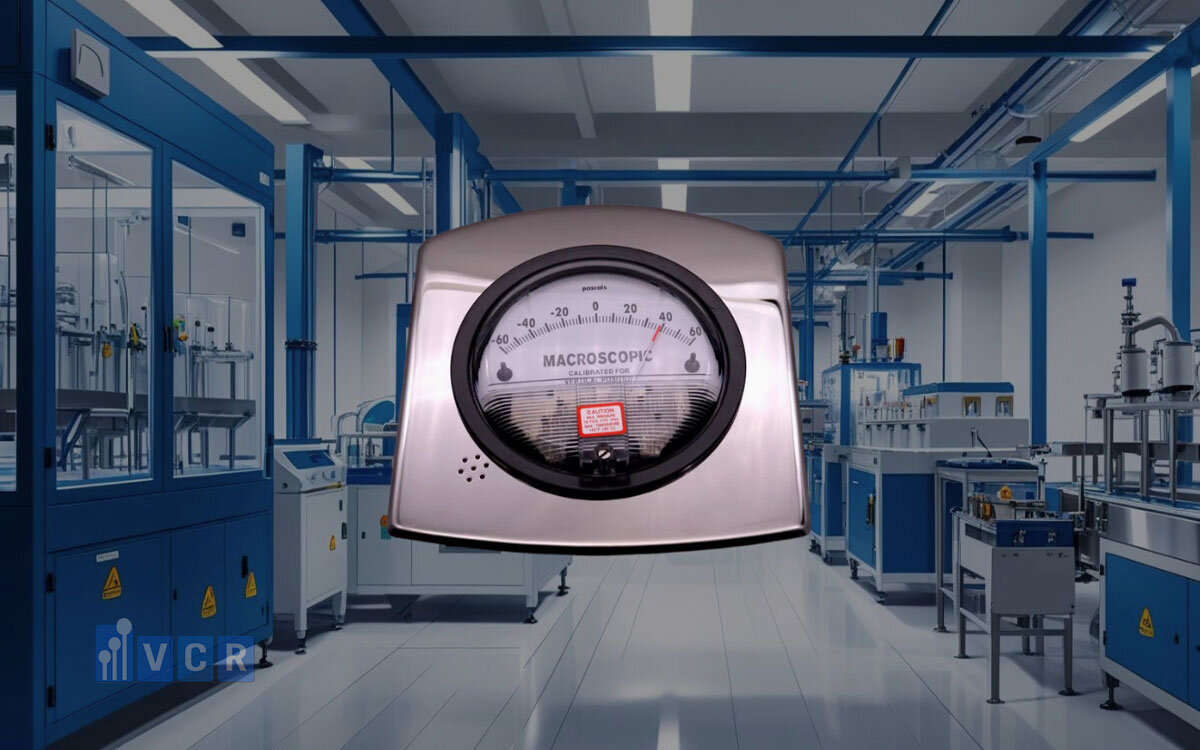
Read more: Instructions for selecting differential pressure gauges for operating rooms that meet MOH standards
6. Notes When Calibrating Differential Pressure Gauges
To ensure the calibration process is accurate and does not interfere with production, some technical and operational notes should be followed:
-
Do not calibrate during normal clean-room production hours
Calibration often requires adjusting pressure between zones—this may disturb airflow or cleanliness. Hence, the procedure should be performed during off‐peak times such as:-
End of shift
-
Weekend
-
During HVAC maintenance
Doing so helps protect product safety, avoids cross‐contamination risk, and prevents disruption of production.
-
-
Always inspect instrument condition before calibration
Before starting calibration, technicians should assess physical condition:-
Is the diaphragm sensor torn or cracked?
-
Are the tubing/connection blocked, kinked, leaking?
-
Is the gauge housing cracked, dirty, or showing pointer deviation?
If damage is discovered, maintenance or replacement should be done before calibration to avoid uncorrectable errors.
-
-
Store calibration records in both electronic and paper formats
After calibration, all records should be archived, including:-
Calibration results sheet (showing errors and pass/fail)
-
Execution report
-
Certificate of reference instrument
-
Calibration label on device
-
Photographs of instrument at calibration time (if needed)
Companies should build dual‐format storage systems to facilitate retrieval, management and avoid loss.
-
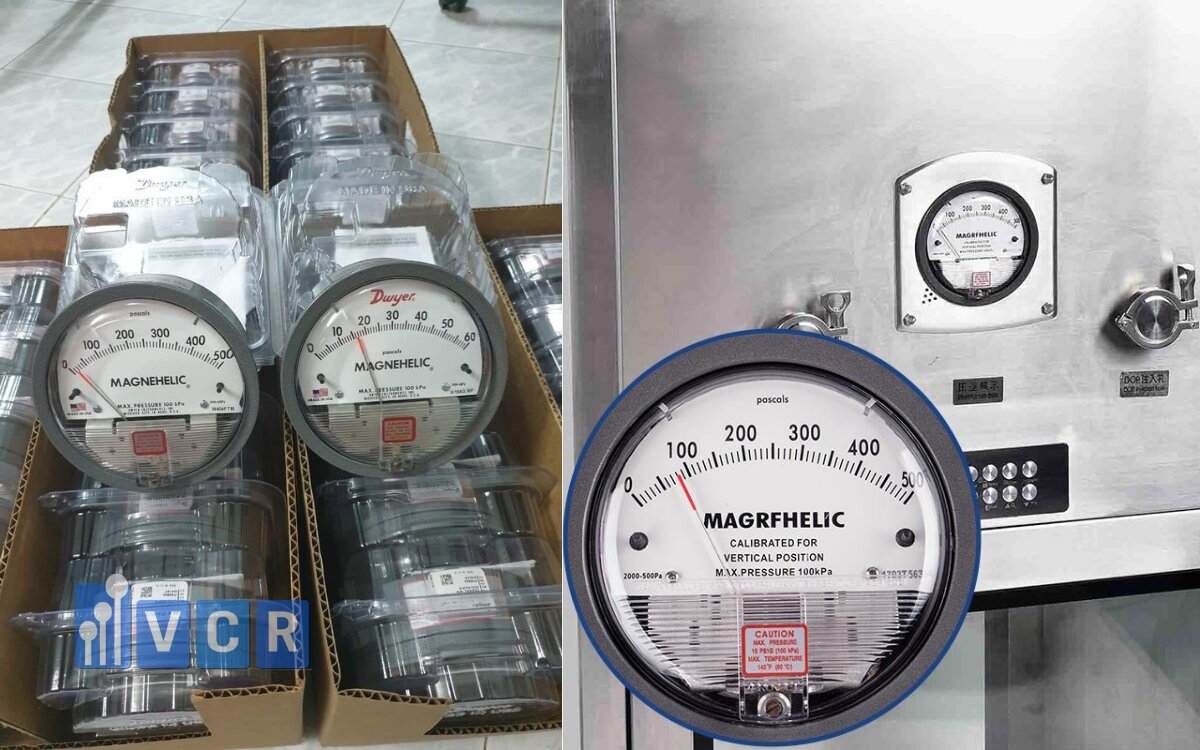
Read more: Provider of Differential Pressure Gauges for Electronic Component Manufacturing Cleanrooms
FAQ
Should differential pressure gauges be calibrated on-site or taken to a lab?
On-site calibration offers many benefits:
-
It evaluates the instrument under actual operating conditions
-
No need to detach from the system ⇒ lower production interruption risk
-
Saves time lost from logistics
However, in some cases, when high accuracy is mandatory or when special environmental conditions are required, the device may need to be taken to a controlled laboratory for calibration.
Can calibration be done internally without external service?
Yes — if the enterprise meets the following conditions:
-
Has calibrated necessary reference equipment and regularly re-calibrates them
-
Technical staff are trained and there are clear SOPs
-
Documentation systems are complete and can stand up to inspection
However, for industries requiring independent verification (pharmaceuticals, export cosmetics), it is often mandatory to use a third‐party accredited unit.
What if calibration is not performed? Are there penalties?
Yes. According to standards like GMP-WHO, ISO 14644 and quality management systems:
-
Failure to calibrate or overdue calibration is considered a serious non‐conformity.
-
During inspections, this is one of the most frequent issues flagged, requiring corrective action or leading to non-approval.
In addition, instruments that measure incorrectly can directly compromise product quality and production environment safety — impacting the enterprise’s credibility.


